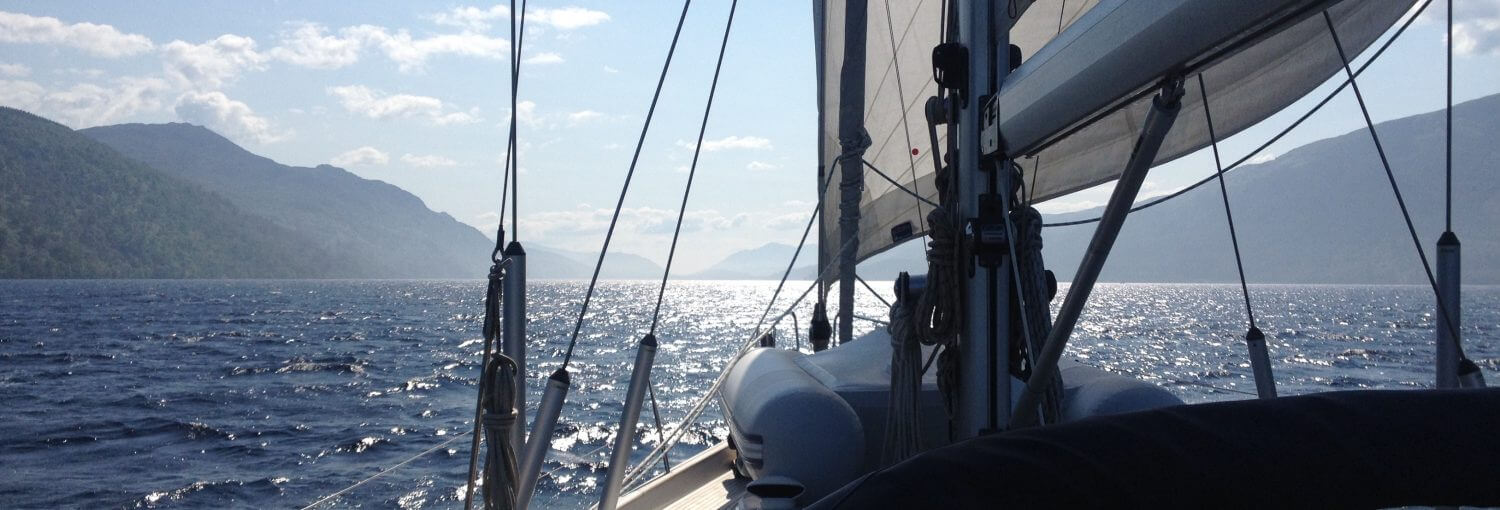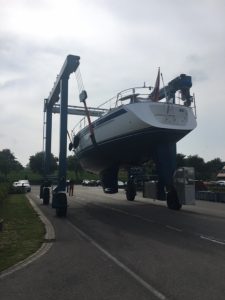We're one step ahead. The boat is on the shore at yachtservice Van Swaay for the final repair. And we are back home. Now we have to wait and see how the repair will go and what the planning will be. We hope that the PYD crew can start delivery to Halifax before Aug 25. But we'll have to wait and see if that's really possible.
The last week on the provisionally repaired boat is still a kind of holiday, but is also about analyzing what we learn from this for ourselves and about the behaviour of our boat. We talk a lot about it with each other and it also comes up regularly when we talk to other sailors. The trip back to Bruinisse we do in three beautiful sailing days via Breskens and Wemeldinge. The boat sails fantastic, partly due to the well set mast, as if nothing had happened. That makes up for a lot.
Back to Dunkirk ... the French male works very hard and neat for two days. What a hero that Frenchman! Van Swaay and the insurance expert (that's Mark Neeleman, a famous olympic sailor, we'll read later) are very pleased with the repair and chances are that this can remain as a basis. Our opinion about French has been adjusted ... we're on the side the morning after the collision and an hour later our hero starts with the repair. He just doesn't speak english, and we speak a little french, so it's hands and feet communicating.
We are glad when we are back in the water, because our boat is on the heavy side for this crane; we weigh 22 tons, the crane can handle max 25 tons. The first day we mainly clean up and put everything back in place, like the anchor with chain back on the bow. We can skip gym for a while ;-). The second day we walk around in Dunkirk and visit the beautiful second world war museum. The Poppedien is also there and we have a nice drink with them for two evenings.
The trip from Dunkirk to Breskens is an excellent sailing trip with half wind, force 4. Great to get some confidence again. We are on edge and listen to every sound, but the boat sails fantastic. The trip from Breksens to Wemeldinge is also nice sailing. In Wemeldinge we can moor the NoMad as well as an HR48. Nice to get acquainted and exchange experiences. Bert and Lian are also lying there and we have a nice chat with them. On Sunday we stay another day in Wemeldinge because we can't go to Wemeldinge until Wednesday. Some chores and messing around on the boat and I make a nice bike ride. In the evening we eat delicious lobster in the restaurant of the marina. The sailing trip to Bruinisse is also fine. Wind force 4 with half to ample wind. We're lucky at the lock; we can come along without having to wait. It is a bit more difficult to manoeuvre without a bow thruster. It doesn't work anymore because it has been standing for a couple of hours in the salty water and died. And then all of a sudden we're back at our own place in Bruinisse, while the intention was not to come here again for another year or so.
We take off the sails and get the boat ready to go. A strange feeling, but also good to close this chapter and continue with the next step ... on the shore for the final repair. Where our SeaQuest will come out better and stronger than she was.
What does analyzing yield for ourselves and the behaviour of the boat?
The big question is of course if and how we could have seen this buoy. The fact is that the buoy was in the middle of the water. Not reported on the (updated) charts. We were sailing on engine, stable course and probably the buoy had been behind our mast for about an hour. We look out every couple of minutes, problem here was that the buoy appears to have a very small light with a very slow transmit frequency. Knowing that far ahead of you you have the shipping lane containing many large ships with lights, it really is a puzzle to get this light out of that knitting of lights. Besides that, it was a dark night (small moon, but thick clouds), which doesn't help either. If we had radar we would have seen it without a doubt. But radar we feed in bad weather, fog or rain. It was a quiet clear night. In addition, this buoy transmits a so-called AIS / AtoN signal. For the non-sailors: a beacon that reports electronically on your plotter screen. Only ... our installation does not receive these specific signals. Toine can now write a book about this, and is in contact with importers and sailing specialists. On the one hand to understand the problem, but also to warn the rest of the sailing community that AIS equipment does not display everything for everyone. A completely unknown problem ....
The fact is, we're skippers on our own ship. And therefore responsible to sail safely with and without electronic aids. And we didn't do that well enough, regardless of the circumstances. For that reason we have also made some changes to our sailing habits, including removing the dinghy in front of the boat during night trips, but also better tying up traps along the mast. Anything to improve forward visibility. A working AIS receiver and transponder has been installed by Toine.
There is also something to tell about our beautiful boat. Fact is that she kept herself fine when we popped the buoy with 7.5 knots. Of course a lot of front damage, but as it turns out it stayed that way. There are no further constructive consequences and that is very good news. It is true that the first watertight bulkhead the boat has is far inside. After the collision, water entered the first 2.5 meters of the boat. Which rose to the top of this watertight bulkhead. If the water had gotten over this, we'd probably have sunk. We are in consultation with the shipyard to at least make a structural adjustment for our boat that will ensure that a watertight bulkhead will come into the boat sooner. But why wasn't this done ex-factory? It seems that all other Hallberg Rassy's have such a shot, and only our type, the 48 feet, do not. We'll work that out with the yard.
It also appears that our pumps can be improved. We have three of them. The first one is a light bilge pump, which is fine for cleaning but not for rescue work. The second is a manual pump with an enormous capacity. We used it to the full and it worked perfectly. But it was extremely heavy to operate it for 2-3 hours. The third is a large electric emergency pump. However, it is quite high in the bilge, and can only work when there is a lot of water in the boat. And that's exactly what you want to prevent... We didn't get anything from this pump and Toine has already put the pump in the bottom of the bilge. Again, the shipyard has asked us what the reason for this is. And in the meantime we have ordered an extra electric emergency pump that we can use anywhere in the boat.
As a family we have learned a lot, with a dual feeling. Given our extensive experience, you would expect us to be able to prevent such a crash. But we are also a bit proud of how we did this. No panic on board, working hard to keep the boat afloat. That's the way it should be, but it has to work under such extreme conditions! Together, including the SeaQuest, we'll come out of this stronger. And fortunately we are also looking forward to new sailing trips, also at night and at sea. Sailing is always a bit of an adventure, only sometimes a bit of a big adventure ;-).




